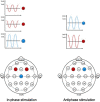Transcranial Current Stimulation as a Tool of Neuromodulation of Cognitive Functions in Parkinson's Disease
- PMID: 35903808
- PMCID: PMC9314857
- DOI: 10.3389/fnins.2022.781488
Transcranial Current Stimulation as a Tool of Neuromodulation of Cognitive Functions in Parkinson's Disease
Abstract
Decrease in cognitive function is one of the most common causes of poor life quality and early disability in patients with Parkinson's disease (PD). Existing methods of treatment are aimed at both correction of motor and non-motor symptoms. Methods of adjuvant therapy (or complementary therapy) for maintaining cognitive functions in patients with PD are of interest. A promising subject of research in this regard is the method of transcranial electric current stimulation (tES). Here we reviewed the current understanding of the pathogenesis of cognitive impairment in PD and of the effects of transcranial direct current stimulation and transcranial alternating current stimulation on the cognitive function of patients with PD-MCI (Parkinson's Disease-Mild Cognitive Impairment).
Keywords: Parkinson disease (PD); mild cognitive impairment (MCI); transcranial alternating current stimulation (tACS); transcranial direct current stimulation (HD-tDCS); transcranial magnetic stimulation (TMS).
Copyright © 2022 Brak, Filimonova, Zakhariya, Khasanov and Stepanyan.
Conflict of interest statement
The authors declare that the research was conducted in the absence of any commercial or financial relationships that could be construed as a potential conflict of interest.
Figures



Similar articles
-
tACS as a promising therapeutic option for improving cognitive function in mild cognitive impairment: A direct comparison between tACS and tDCS.J Psychiatr Res. 2021 Sep;141:248-256. doi: 10.1016/j.jpsychires.2021.07.012. Epub 2021 Jul 6. J Psychiatr Res. 2021. PMID: 34256276
-
Mild cognitive impairment in Parkinson's disease is improved by transcranial direct current stimulation combined with physical therapy.Mov Disord. 2016 May;31(5):715-24. doi: 10.1002/mds.26561. Epub 2016 Feb 16. Mov Disord. 2016. PMID: 26880536
-
Transcranial direct current stimulation enhances theory of mind in Parkinson's disease patients with mild cognitive impairment: a randomized, double-blind, sham-controlled study.Transl Neurodegener. 2019 Jan 7;8:1. doi: 10.1186/s40035-018-0141-9. eCollection 2019. Transl Neurodegener. 2019. PMID: 30627430 Free PMC article.
-
The Effects of Non-Invasive Brain Stimulation on Quantitative EEG in Patients With Parkinson's Disease: A Systematic Scoping Review.Front Neurol. 2022 Mar 2;13:758452. doi: 10.3389/fneur.2022.758452. eCollection 2022. Front Neurol. 2022. PMID: 35309586 Free PMC article.
-
Neuromodulation of cognition in Parkinson's disease.Prog Brain Res. 2022;269(1):435-455. doi: 10.1016/bs.pbr.2022.01.016. Epub 2022 Feb 11. Prog Brain Res. 2022. PMID: 35248205 Free PMC article. Review.
Cited by
-
Noninvasive Therapies: A Forthcoming Approach to Parkinson's Treatment.CNS Neurol Disord Drug Targets. 2025;24(3):165-180. doi: 10.2174/0118715273318429240812094557. CNS Neurol Disord Drug Targets. 2025. PMID: 39225218 Review.
-
Noninvasive Neuromodulation in Parkinson's Disease: Insights from Animal Models.J Clin Med. 2023 Aug 22;12(17):5448. doi: 10.3390/jcm12175448. J Clin Med. 2023. PMID: 37685514 Free PMC article. Review.
-
Therapeutic innovations for the symptomatic treatment of Parkinson's disease: focus on technology-based therapies.J Neural Transm (Vienna). 2025 Mar 22. doi: 10.1007/s00702-025-02915-1. Online ahead of print. J Neural Transm (Vienna). 2025. PMID: 40119890 Review.
-
Transcranial alternating current stimulation improves quality of life in Parkinson's disease: study protocol for a randomized, double-blind, controlled trial.Trials. 2024 Mar 20;25(1):200. doi: 10.1186/s13063-024-08045-5. Trials. 2024. PMID: 38509589 Free PMC article.
References
Publication types
LinkOut - more resources
Full Text Sources
Medical

